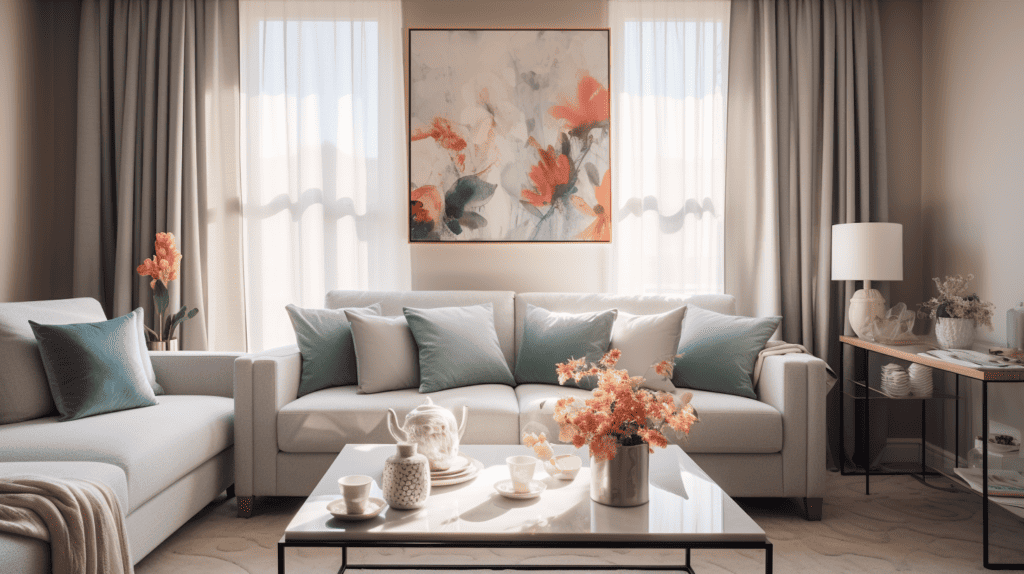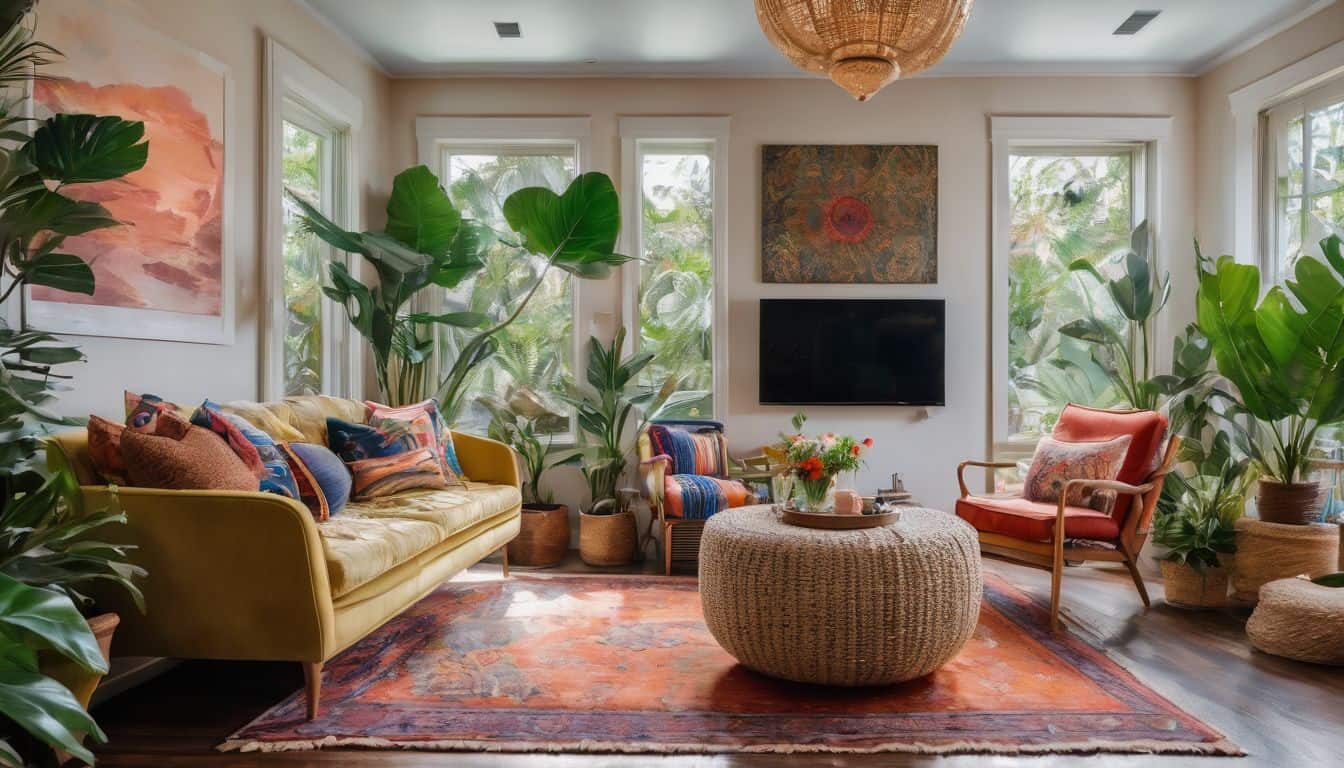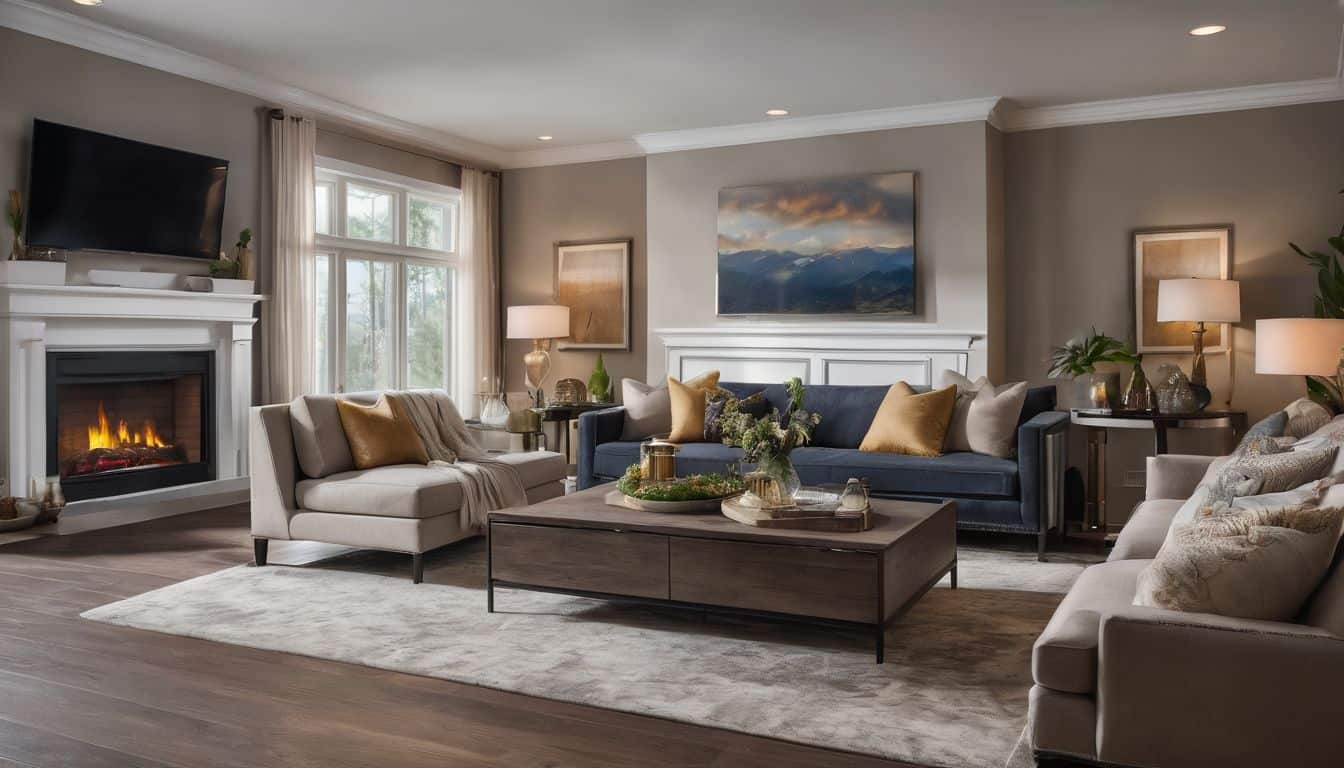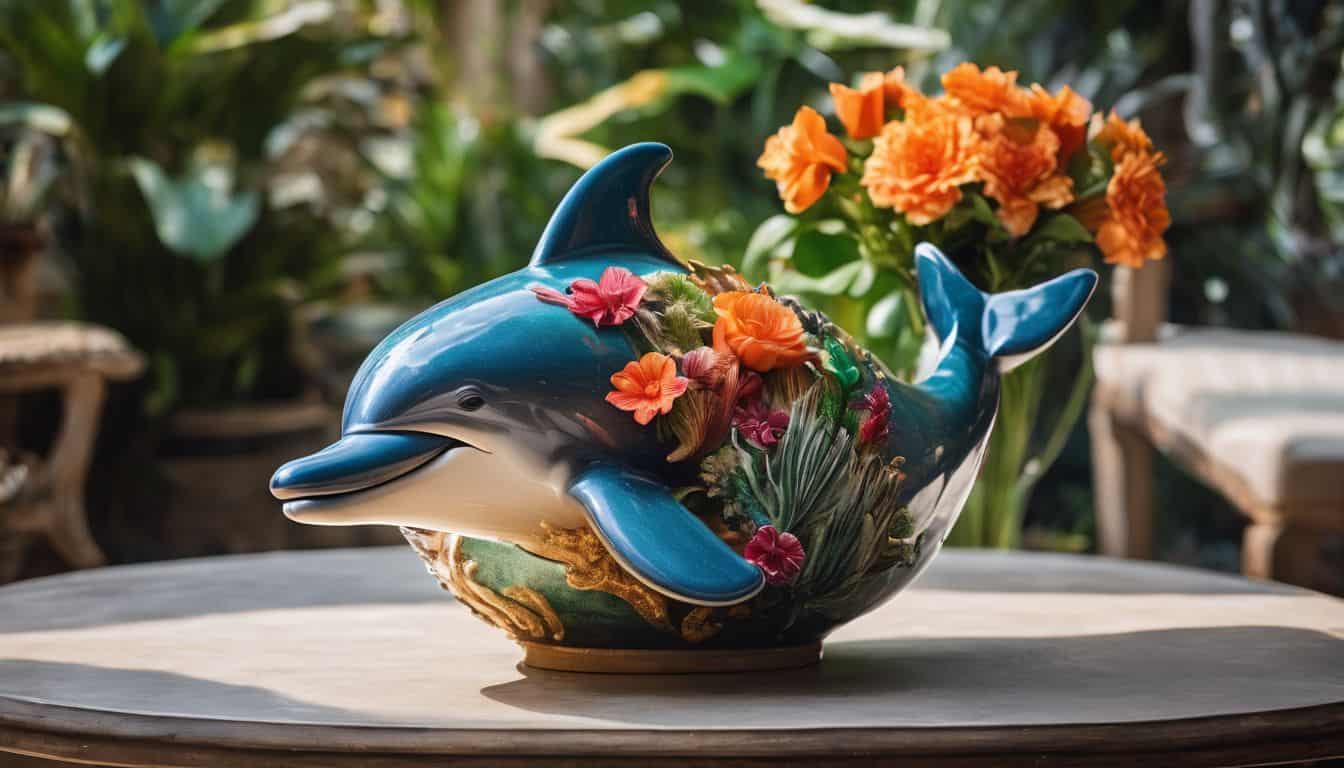Have you ever felt overwhelmed trying to transform a dull room into a gorgeous, welcoming space? Believe me, I’ve been there too, so I had to learn the basics of home decor. As it turns out, mastering home decor doesn’t require an Interior Design Degree or loads of money; all it takes is understanding some foundational techniques and principles.
In this blog post, we will demystify interior design basics and take you on a journey from novice decorator to a confident stylist in easy steps. So are you ready to let your inner designer shine?
Key Takeaways
- Mastering home decor doesn’t require a degree or loads of money; it’s about understanding foundational techniques and principles.
- Understanding your goals, purpose, and budget is crucial for a home decor project.
- Exploring different interior design styles such as traditional, contemporary, mid-century modern, modern farmhouse, bohemian, art deco, Hollywood regency, Asian zen, and urban can help you find your unique style.
- Designing with space and lighting in mind ensures functionality and ambiance in your living areas.
- Choosing the right colors and furniture can elevate the look of any room.
- Adding finishing touches with decorative accessories completes the overall aesthetic of your home decor.
Understanding the Basics of Home Decor
Step 1
Hanging curtains up to the ceiling can create additional vertical lines, giving the illusion of a taller and more spacious area.
Step 2
The depth of the curtains stack significantly contributes to a full and rich appearance. Strive for one inch of stacking space for every foot of height.
Step 3
Placing artwork in alignment with the architecture or other pieces can help establish balance, scale, and proportion. This technique visually enhances the space, giving an impression of a larger area.
Step 4
Aim for at least half the furniture’s weight on the carpet when using rugs. This helps to ground the space. If 75% of the furniture’s weight is on the rug, it will define the area more clearly.
Step 5
Good lighting is crucial for augmenting the space. Aim for three different light sources: overhead lights, lamps, sconces, or floor lamps. This approach helps in creating various moods and layers of lighting.
Step 6
Scale, a vital design principle, refers to the visual weight and size of objects in space in relation to each other and the overall length. Consider how different pieces interact and strive for balance and proportion.
Step 7
Consider variety and balance when arranging pillows, particularly on a sofa or bed. A mixture of large and small pillows can create a visually exciting look. Start with more giant pillows at the back, then layer them with smaller ones in front. Using an odd number of pads, like three or five, can help create a dynamic, asymmetrical design that’s visually interesting.
Understanding Your Goals and Budget
Identify the space you want to decorate, determine your desired outcome and purpose for the area, and assess your budget for the project.
Here is a table to give you an idea of the lowest budget items based on cost:
| Item | Cost |
|---|---|
| Sofa | $$$ |
| Coffee Table | $$ |
| Floor Lamp | $$ |
| Area Rug | $$ |
| Wall Art | $$ |
| Bookshelf | $$ |
| Dining Table | $$$ |
| Dining Chairs | $$ |
| Bed Frame | $$$ |
| Mattress | $$$ |
| Bedside Table | $$ |
| Desk | $$ |
| Office Chair | $$ |
| Curtains | $ |
| Decorative Pillows | $ |
| Vase | $ |
| Indoor Plants | $ |
Please note that these prices are approximate and may vary based on the brand, quality, and location. The key indicates that $ represents a low-cost item, $$ represents a medium-cost item, and $$$ represents a high-cost item.
Identifying the space you want to decorate (living room, bedroom, bathroom, kitchen)

Embarking on your interior design journey starts with choosing which area of your home to transform. This could be any room: the living room where families gather, the bedroom as a personal sanctuary, the kitchen where culinary magic happens, or the bathroom that provides relaxation and rejuvenation.
The chosen space sets the tone for your decorating style and function needs. Don’t avoid considering aspects such as how often you use this space and its size because it’s vital in streamlining our decor decisions later on.
Taking time in this stage will clarify what elements are necessary to achieve not just an aesthetically pleasing environment but one that is functional and suits your lifestyle, too— thus making mastering the basics of home decor a fun and fulfilling experience.
Determining your desired outcome and purpose for the space
Choosing your desired product and goal is an essential first step when decorating a space in your home. You need to have a clear vision of what you want the room to look like and how you want it to function.
Are you looking for a cozy living room where you can relax with family and friends? Or maybe a serene bedroom that promotes restful sleep? By understanding your goals for the space, you can make design choices that align with your vision.
Additionally, considering the room’s purpose will help guide decisions on furniture placement, lighting, and color schemes. Whether creating a functional workspace or setting up an inviting entertainment area, knowing what you hope to achieve will ensure that every element of your home decor contributes to the overall ambiance and functionality.
Assessing your budget for the project

When embarking on any home decor project, assessing your budget is crucial. Understanding how much you’re willing and able to spend will help guide your decisions.
Consider the scale of the project and allocate funds accordingly, factoring in expenses for furniture, paint, accessories, and any professional services you may require. Remember that it’s always a good idea to leave some room for unexpected costs that may arise along the way.
By being mindful of your budget from the start, you can ensure that your home decor journey stays on track and within financial reach.
Exploring Different Interior Design Styles
This section will delve into various interior design styles, including traditional, contemporary, mid-century modern, modern farmhouse decor, bohemian style interior design, art deco interior design, Hollywood regency interior design, Asian zen interior design, and urban interior decor.
Traditional design
As a home designer, one of the interior design styles you’ll frequently encounter is traditional design. This timeless and classic style draws inspiration from European influences and features rich colors, elegant furnishings, and intricate details.
With its emphasis on symmetry and formal arrangements, the traditional design creates an inviting atmosphere that exudes warmth and sophistication. Incorporating ornate moldings, antique furniture pieces, plush textiles, and refined accessories will help you achieve this look effortlessly.
So whether you’re aiming to create a cozy living room or a luxurious bedroom retreat with a touch of history, exploring the world of traditional design can be an exciting journey for any aspiring home decorator.
Contemporary design
I love the sleek and modern look of contemporary design. It’s all about clean lines, minimalist furniture, and a neutral color palette with pops of bold colors. This style creates a sense of openness and simplicity in any space.
Think spacious living rooms with comfortable yet stylish furniture and accessories that make a statement without overwhelming the space. Incorporating the basics of home decor into your home decor is a great way to create a modern and sophisticated atmosphere.
Don’t be afraid to mix different materials like glass, metal, and wood for added texture and visual interest. With a contemporary design, you can achieve an effortlessly chic look that will impress anyone who walks through your door.
Mid-Century Modern design

Mid-Century Modern design is a popular interior design style that emerged in the mid-20th century and continues to be highly sought after today. Clean lines, organic shapes, and a focus on functionality characterize this design aesthetic.
With its timeless appeal, Mid-Century Modern decor brings a sense of sophistication and elegance to any space. The use of natural materials like wood and leather and iconic furniture pieces such as the Eames lounge chair or the Saarinen tulip table are key elements of this style.
By incorporating Mid-Century Modern design into your home decor, you can create a cohesive and stylish look that stands the test of time.
Modern Farmhouse decor

Modern Farmhouse decor combines the warmth and charm of traditional farmhouse style with the clean lines and simplicity of modern design. It embraces a cozy, rustic aesthetic while incorporating contemporary elements for a fresh, updated look.
With its blend of natural materials, neutral color palette, and vintage-inspired accents, Modern Farmhouse decor creates a welcoming and comfortable atmosphere in any space. This style celebrates simplicity and authenticity, from reclaimed wood furniture to distressed finishes to barn-style lighting fixtures.
You can create a timeless and inviting space that exudes character and comfort by incorporating Modern Farmhouse elements such as shiplap walls, open shelving, and farmhouse sinks into your home decor.
Bohemian-style interior design

Bohemian style interior design is all about embracing a free-spirited and eclectic aesthetic. It’s perfect for those who love vibrant colors, unique patterns, and different textures.
With Bohemian decor, you can create a space that feels relaxed, cozy, and full of personality. This style uses natural materials like rattan, wicker, and jute and incorporates vintage furniture and handmade accessories.
You can achieve the boho look effortlessly by adding elements like macrame wall hangings, colorful throw pillows, and layered rugs with intricate designs. So why not bring out your inner gypsy with Bohemian-style interior design? Let your creativity flow and infuse your home with warmth and character!
Art Deco interior design
Art Deco interior design is a glamorous and luxurious style that emerged in the 1920s. Bold geometric patterns, sleek lines, and a rich color palette characterize it. This elegant style often incorporates chrome, mirrors, lacquer, and exotic woods.
Art Deco embraces luxury and sophistication, emphasizing lavish furnishings and statement pieces.
Choose furniture with clean lines and streamlined shapes to achieve an Art Deco look in your home decor. Look for pieces that feature geometric motifs or abstract designs. Incorporate luxurious materials like velvet or satin for upholstery to add a touch of glamour.
When it comes to colors, opt for bold shades such as deep blues, vibrant yellows, or striking reds. These hues will create a dramatic contrast against neutral walls or flooring. This will help with your new knowledge on the basics of home decor.
Accessorize your space with eye-catching art deco-inspired accessories like decorative vases, lamps with geometric patterns, or sculptures that showcase this iconic era.
Hollywood Regency interior design
One of the most glamorous and elegant interior design styles is Hollywood Regency. This style draws inspiration from the golden age of Hollywood, featuring luxurious and opulent elements. Think bold colors, mirrored furniture, geometric patterns, and metallic accents.
A key characteristic of Hollywood Regency is its ability to create a sense of drama and sophistication in any space. With this design style, you can transform your home into a glamorous retreat that exudes timeless elegance.
So if you’re looking to infuse a touch of old-world charm with a modern twist, Hollywood Regency might be the perfect choice for your home decor endeavors.
Asian Zen interior design
Asian Zen interior design is a popular style that embodies tranquility and mindfulness. Drawing inspiration from traditional Japanese and Chinese aesthetics, this design approach creates a peaceful and harmonious atmosphere in the home.
Using natural materials such as bamboo, wood, and stone, Asian Zen design promotes simplicity and clean lines to foster a sense of tranquility. Incorporating elements like low furniture, minimalistic decor, and subdued colors like neutral tones or soft pastels, the Asian Zen interior design encourages relaxation and introspection.
By creating a space that exudes serenity and balance, you can transform your home into a sanctuary where you can find peace amidst the chaos of everyday life.
Urban interior decor
I’ve always been drawn to the sleek and modern style of urban interior decor. It’s all about creating a sophisticated, metropolitan vibe in your home that reflects the energy and excitement of city living.
Think clean lines, minimalistic furnishings, and a color palette dominated by neutral tones with pops of bold colors. The urban interior decor is perfect for those who appreciate simplicity and functionality while wanting to make a statement with their design choices.
Incorporate industrial elements like exposed brick walls or metal accents into your space to achieve this look. This adds an edgy and urban feel to any room. Use concrete or stainless steel for countertops, furniture pieces, or light fixtures to enhance that modern aesthetic.
Choose streamlined designs with clean edges rather than ornate details for furniture selection. Furniture made from leather or suede can also add a touch of luxury to your urban-inspired space.
Don’t be afraid to mix different textures and materials—this will add depth and visual interest to your interior decor.
In terms of lighting, choose fixtures with an industrial feel, such as pendant lights with metal shades or exposed bulbs. Incorporating floor lamps or track lighting can also help create a well-lit atmosphere.
Remember that achieving the perfect urban interior decor style balances function and aesthetics. Focus on decluttering your space and using intelligent storage solutions to keep everything organized without sacrificing style.
Designing with Space and Lighting
Use effective space planning techniques and proper lighting strategies to create a functional and visually appealing space. Please find out how to make the most of your home’s layout and enhance its atmosphere with expert tips on optimizing space and creating the perfect lighting ambiance.
Utilizing space effectively for optimal functionality and aesthetics
One key aspect of mastering home decor is effectively learning to use space for functionality and aesthetics. By understanding the layout of your room and making strategic design choices, you can create a space that looks great and works well for your needs. Our decorating 101 post will help with some of the basics.
Consider the room’s purpose and how you want to use it – whether it’s a cozy living room or a functional kitchen. Consider the flow of movement within the space, ensuring enough room for people to navigate comfortably.
Additionally, think about clever storage solutions that maximize your space while keeping clutter at bay. Lighting also plays a crucial role in enhancing both functionality and aesthetics – make sure to utilize different types of lighting (ambient, task, accent) to create layers and set the right mood in each area of your home.
Implementing proper lighting techniques for different areas of the home (kitchen, living room, bedroom, apartment)
Proper lighting techniques are essential when creating the perfect ambiance in your home. For example, task lighting is crucial in the kitchen to ensure efficient meal preparation and cooking.
Consider installing under-cabinet or pendant lights above the island to provide adequate illumination for chopping vegetables or reading recipes. In the living room, aim for ambient lighting through overhead fixtures and accent lighting with table or floor lamps to create a warm and inviting atmosphere.
For the bedroom, choose soft and diffused lighting options like bedside sconces or dimmable ceiling lights to promote relaxation and restful sleep. And in smaller spaces like apartments, maximize natural light by using sheer curtains or blinds that allow sunlight to filter in a while providing privacy during nighttime hours.
Choosing the Right Colors and Furniture

In this section, we’ll explore how to select the perfect paint colors to create the desired ambiance and style for your space. We’ll also discuss choosing furniture that complements your style and meets your functional needs.
Discover the secrets of transforming your home with color and furniture choices! This is one of the basics of home decor.
Selecting paint colors that complement your desired style and create the desired ambiance
Choosing the right paint colors is essential in creating harmonious and visually appealing home decor. When selecting paint colors, it’s necessary to consider your desired style and the ambiance you want to make in each room.
For example, earthy tones like beige, taupe, or warm greys can create a cozy atmosphere. On the other hand, if you prefer a more vibrant and energetic feel, bold colors like reds or blues can be great choices.
Remember that different colors evoke different emotions and moods, so it’s crucial to remember this when making your selection. Additionally, consider how natural light affects the space throughout the day.
Natural light can vary depending on the location and orientation of windows, which may affect how the paint color appears.
Lastly, don’t be afraid to experiment with color samples before committing to a specific shade. Take advantage of free online guides or downloadable PDF resources that provide valuable insights into color theory and complementary color schemes.
Incorporating furniture that aligns with your style and meets your functional needs
When it comes to home decor, choosing the right furniture is crucial in creating a space that aligns with your style and meets your functional needs. Whether you prefer a modern minimalist look or a cozy farmhouse aesthetic, selecting furniture pieces that complement your chosen interior design style will enhance the overall ambiance of your home.
Additionally, considering the functionality of each piece is essential for creating a space that looks great and serves its purpose effectively. From comfortable sofas and stylish dining tables to practical storage solutions, investing in furniture that balances aesthetics and functionality will elevate your home decor game to a pro level.
Remember, furniture acts as statement pieces and everyday essentials in your living space, so make sure each item reflects your style while fulfilling its intended purpose.
Adding the Finishing Touches with Decorative Accessories
Enhance your space with stylish pillows, rugs, and other decorative elements to make it your own. Discover creative ways to personalize your home decor and put the finishing touches on your design masterpiece.
Enhancing your space with pillows, rugs, and other decorative elements
One of the easiest and most effective ways to add personality and style to your home decor is by incorporating pillows, rugs, and other decorative elements. These simple additions can instantly transform a room from ordinary to extraordinary.
Choose pillows in different shapes, sizes, and textures to create depth and visual interest on your couch or bed. Opt for rugs that complement your overall design style while providing comfort underfoot.
And don’t forget about other decorative accessories like vases, candles, artwork, or wall hangings that can truly personalize your space. By carefully selecting these finishing touches, you can elevate the look and feel of any room in your home without breaking the bank.
Exploring creative ways to personalize your home decor
As a home designer, one of the most exciting aspects of creating beautiful spaces is finding unique and innovative ways to personalize your home decor. Adding those personal touches makes your room feel more inviting and comfortable and showcases your style and personality.
There are endless possibilities for personalization, from customizing artwork or photography displays to incorporating sentimental items that hold special meaning for you. Don’t be afraid to think outside the box and experiment with different textures, colors, and patterns that resonate with you.
Mixing vintage finds with modern pieces or repurposing old furniture can also add a touch of character and originality to your space. The key is to let your creativity flow and have fun while bringing your vision to life in each room.
Personalizing your home decor doesn’t always require significant investments or major renovations. Small changes like switching out throw pillows, rearranging accessories on shelves, or adding a gallery wall can significantly impact a room’s overall atmosphere.
Pay attention to details like scented candles or fresh flowers that add a layer of charm and create an inviting ambiance in any space. Ultimately, the goal is to create a home that reflects who you are while providing comfort and functionality for yourself and others who enter it.
Recapping the Basics of Home Decor
In the article, we reviewed so many topics; here is what we discussed below:
First, we started by understanding your goals and budget. Whether it’s revamping your living room, bedroom, bathroom, or kitchen, identifying the space you want to decorate is essential. Next, we’ll explore different interior design styles such as traditional, contemporary, mid-century modern, and more so you can find a manner that aligns with your preferences.
Designing with space and lighting is another crucial aspect we’ll cover – utilizing space effectively for optimal functionality and implementing proper lighting techniques for different areas of your home.
Choosing the right colors and furniture is crucial in creating a cohesive look. I’ll provide tips on selecting paint colors that set the desired ambiance and incorporating furniture that suits your style and functional needs.
Lastly, we discussed adding those finishing touches with decorative accessories like pillows, rugs, and other elements that enhance your space’s character. Ready to become a pro at home decor?
Conclusion and final thoughts 💭
In conclusion, mastering home decor basics is an achievable goal for anyone, from novices to aspiring professionals. By understanding your goals and budget, exploring different interior design styles, designing with space and lighting in mind, choosing the right colors and furniture, and adding the finishing touches with decorative accessories, you can transform your living spaces into stylish havens.
With resources like online courses and free guides available, learning interior design has never been easier. So go ahead and unleash your creativity – it’s time to become a pro at home decor!
FAQs
1. What are the essential basics of home decor?
The essential elements of home decor include furniture, lighting, color schemes, textures, and accessories such as artwork and decorative items.
2. How do I choose a suitable color scheme for my home?
Choosing a suitable color scheme involves considering personal preference, room function, natural light exposure, and desired mood or atmosphere. Creating a cohesive color palette that harmonizes with your home’s overall style and theme is essential.
3. What are some easy steps to improve the lighting in my home?
Improving the lighting in your home can be achieved through various methods, such as adding additional light fixtures or lamps in areas that lack adequate lighting, choosing bulbs with appropriate brightness levels for each space, incorporating natural light sources like windows or skylights, and using reflective surfaces to enhance brightness.
4. How can I add personality to my home decor?
Adding personality to your home decor can be done by including unique pieces that reflect your taste and interests. This could involve displaying cherished mementos or collections, incorporating artwork or photographs that hold sentimental value, selecting furniture or accessories with distinctive designs or patterns, and infusing pops of color through accent pieces.
Additional Resources:
https://www.masterclass.com/articles/interior-design-basics
https://www.decoraid.com/beginners-guide-to-interior-design/
https://www.thespruce.com/decorating-101-interior-design-basics-4102142
https://www.domestika.org/en/blog/9796-10-online-interior-design-courses-for-easy-home-decor-ideas





Leave a Reply